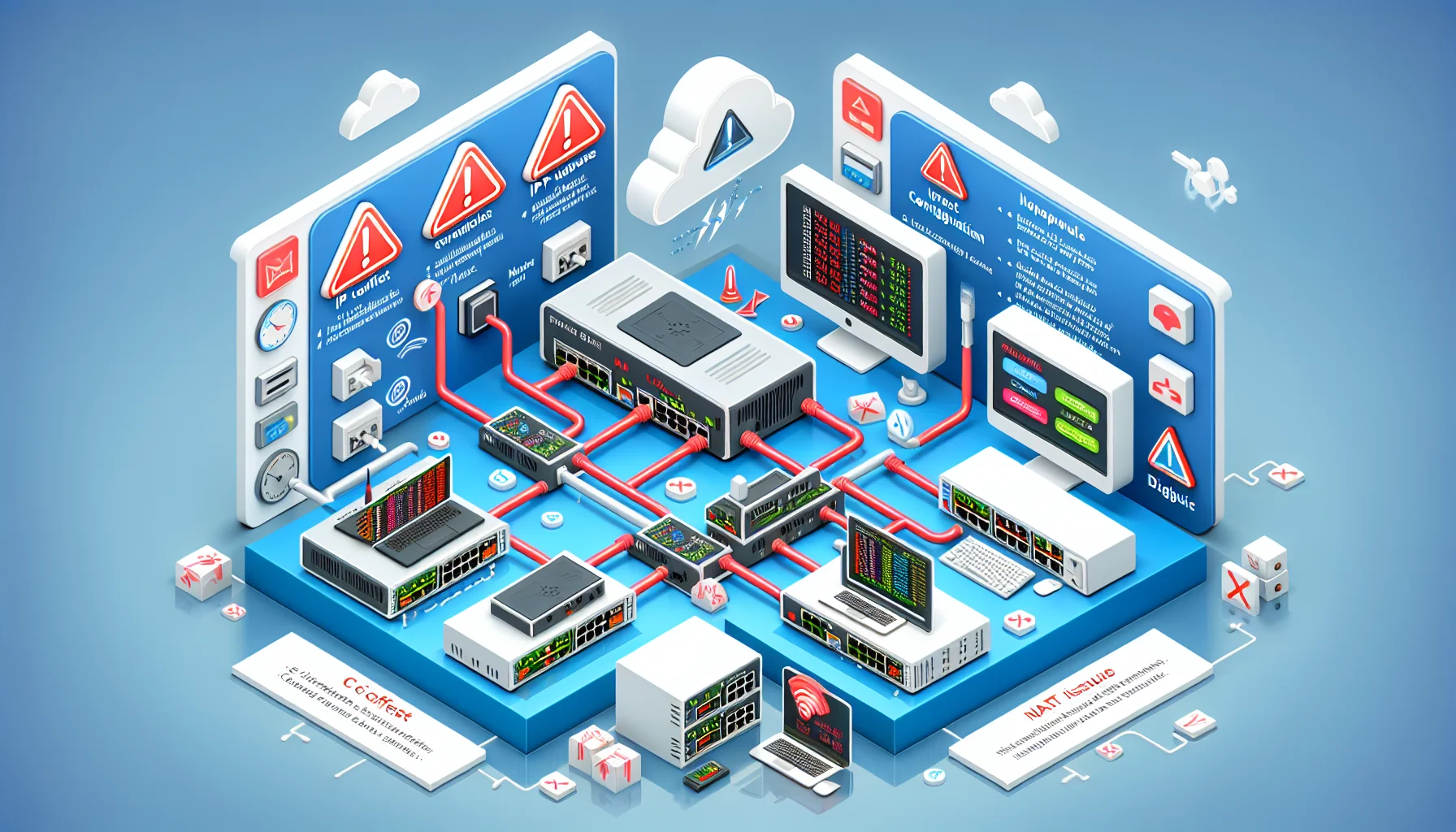Common IP Address Issues and Solutions
IP address-related problems can disrupt your internet connectivity and network performance. This article highlights common issues such as IP conflicts, incorrect configurations, and NAT problems, providing practical solutions for each. Readers will learn troubleshooting steps to identify and resolve these issues efficiently, ensuring a stable network environment. This resource is invaluable for both novice and experienced users facing connectivity challenges.


In the fast-paced world of digital connectivity, IP address-related issues can significantly affect your internet experience. Whether you are a casual user browsing the web, a small business owner managing a network, or an IT professional troubleshooting network performance, understanding common IP address problems is essential. This article will delve deep into frequent IP address issues such as conflicts, misconfigurations, and Network Address Translation (NAT) problems, providing practical solutions and expert insights to help you restore and maintain a stable network environment.
Common IP Address Issues
1. IP Address Conflicts
One of the most prevalent IP address issues is the conflict that arises when two devices on the same network are assigned the same IP address. This situation creates confusion for routers and leads to connectivity problems for the affected devices.
Understanding IP Conflicts
When a device connects to a network, it is assigned an IP address, typically by a DHCP (Dynamic Host Configuration Protocol) server. If another device is assigned the same address—either manually or through another DHCP server—a conflict occurs. This can manifest in various ways, such as intermittent connectivity, inability to access the internet, or error messages indicating that the IP address is already in use.
Real-World Example
Consider a home network where a user manually sets a static IP address for a printer while the DHCP server also assigns that same address to a newly connected laptop. Both devices will struggle to communicate over the network, leading to printing failures and connectivity drops.
Troubleshooting IP Address Problems
When two devices on the same network are assigned the same IP address, it results in an IP conflict. To understand how IP addresses are assigned and managed, see our article on understanding public vs private IP addresses. To resolve IP address conflicts, follow these steps:
-
Identify Conflicted Devices: Use the command line to check for conflicts. On Windows, the command
arp -awill display a list of devices and their IP addresses. On Linux, you can useip neigh. -
Release and Renew IP Addresses: On the affected devices, release and renew their IP addresses. For Windows, use
ipconfig /releasefollowed byipconfig /renew. On Linux, usesudo dhclient -rand thensudo dhclient. -
Check DHCP Settings: Ensure that the DHCP server's address pool does not include static IP addresses assigned to devices. For home routers, access the admin panel typically via
192.168.1.1or192.168.0.1and adjust the DHCP settings accordingly. -
Consider Static IP Reservations: If certain devices require static IPs, configure DHCP reservations so the server assigns the same IP to specific devices based on their MAC addresses.
2. Incorrect IP Configuration
Misconfigurations in IP settings can lead to numerous connectivity issues. This encompasses incorrect subnet masks, default gateways, or DNS server settings.
Understanding IP Configuration Issues
Each IP address is part of a larger network, defined by a subnet mask, which dictates how the network is structured. If these settings are incorrect, devices may be unable to communicate with each other or access external networks.
Real-World Example
Imagine a scenario where a user sets their device to a static IP address of 192.168.1.50, but the default gateway is incorrectly set to 192.168.2.1. This mismatch means the device can communicate with others on the 192.168.1.x subnet but cannot access the internet or devices on different subnets.
Troubleshooting Incorrect Configurations
To troubleshoot IP configuration issues, proceed as follows:
-
Verify IP Address Settings: On Windows, use
ipconfigto view the current IP configuration. On Linux,ifconfigorip addr showcan be used. -
Check Subnet Mask and Gateway: Ensure that the subnet mask aligns with the network architecture. For a typical home network, it should often be
255.255.255.0. Verify that the default gateway matches the router's IP address. -
DNS Settings: Incorrect DNS settings can also cause internet access issues. Test connectivity by pinging an external IP address (e.g.,
ping 8.8.8.8). If this works but a domain name does not, the issue likely lies with DNS. Set DNS to a reliable server such as Google's8.8.8.8. -
Use Command-Line Tools: Leverage tools like
tracert(Windows) ortraceroute(Linux) to diagnose routing issues. This can help identify where packets are being dropped.
3. Network Address Translation (NAT) Problems
NAT is a critical function that allows multiple devices on a local network to share a single public IP address. However, misconfigurations can lead to connectivity issues, especially in complex network setups.
Understanding NAT Issues
NAT translates private IP addresses to a public IP address for internet access. When NAT is misconfigured, it can lead to problems such as unreachable services or inability to connect to external networks.
Real-World Example
Consider a small business running a web server on a private IP address (192.168.1.100) behind a router that uses NAT. If NAT is not properly configured to forward requests to the web server, users outside the network will be unable to access the website.
Troubleshooting NAT Problems
To resolve NAT issues, follow these steps:
-
Check NAT Settings on the Router: Access the router's admin interface and ensure that port forwarding rules are correctly set up. For instance, to access a web server, port 80 (HTTP) should forward traffic from the public IP to the internal IP of the server.
-
Use Static NAT for Servers: For devices that need to be consistently reachable from the internet, consider using static NAT, which maps a specific internal IP address to a static external IP.
-
Test Connectivity: Use online tools like
canyouseeme.orgto check if the ports you expect to be open are actually accessible from the outside world.
4. Best Practices for IP Address Management
Preventing IP address problems requires careful management and adherence to best practices. Here are some strategies to consider:
Implementing a Structured IP Addressing Scheme
-
Use Subnetting: Segment your network into subnets to minimize broadcast traffic and improve performance. For example, a larger organization might use
/24subnets to separate departments. -
Document IP Allocations: Maintain a spreadsheet or database of assigned IP addresses, including static assignments and DHCP pools, to prevent conflicts.
-
Regularly Audit the Network: Periodically review the network using IPAM tools to identify and address any addressing issues.
-
Educate Users: Provide training for users on the importance of correct IP configurations and the risks associated with static IP assignments.
IP address issues can significantly disrupt network performance and connectivity. By understanding common problems such as IP conflicts, incorrect configurations, and NAT issues, users can take proactive steps to troubleshoot and resolve these challenges. Implementing best practices for IP address management will further enhance network stability and efficiency. Whether you are a novice user or an experienced IT professional, this guide serves as a valuable resource to navigate the complexities of IP networking and ensure a robust and reliable internet experience.
Related Articles
About the Author

Marilyn J. Dudley
Marilyn is a Senior Network Engineer with over 15 years of experience in network infrastructure design and implementation. She holds CCNA and CCNP certifications and specializes in IP addressing, network security, and IPv6 migration strategies. Throughout her career, she has successfully led numerous large-scale network deployments and IPv6 transition projects for Fortune 500 companies. She is currently a dedicated writer for ipaddress.network, sharing her expertise to help organizations build secure and efficient networks.
Last updated: January 12, 2025



